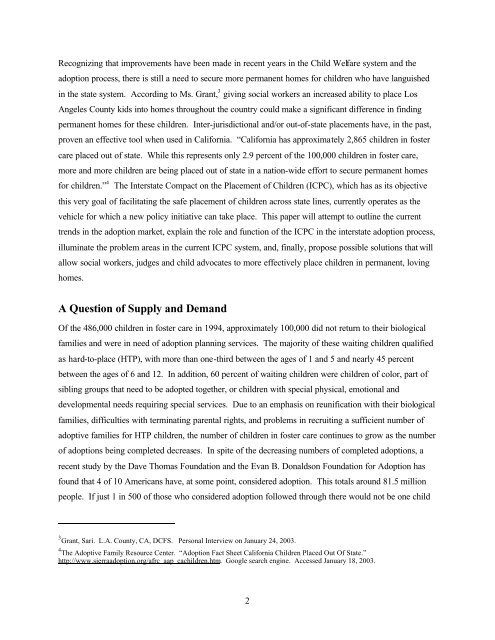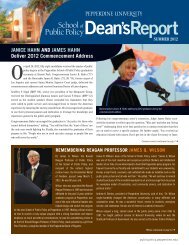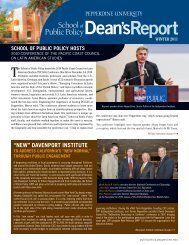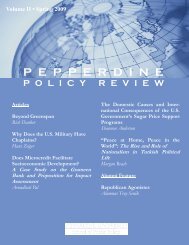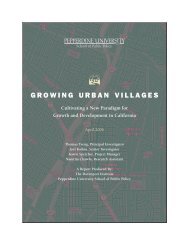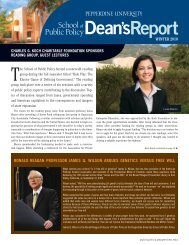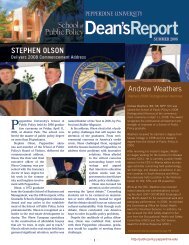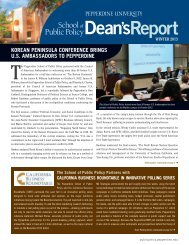Finding Permanent Homes for Adoptable Children - Pepperdine ...
Finding Permanent Homes for Adoptable Children - Pepperdine ...
Finding Permanent Homes for Adoptable Children - Pepperdine ...
You also want an ePaper? Increase the reach of your titles
YUMPU automatically turns print PDFs into web optimized ePapers that Google loves.
Recognizing that improvements have been made in recent years in the Child Welfare system and the<br />
adoption process, there is still a need to secure more permanent homes <strong>for</strong> children who have languished<br />
in the state system. According to Ms. Grant, 3 giving social workers an increased ability to place Los<br />
Angeles County kids into homes throughout the country could make a significant difference in finding<br />
permanent homes <strong>for</strong> these children. Inter-jurisdictional and/or out-of-state placements have, in the past,<br />
proven an effective tool when used in Cali<strong>for</strong>nia. “Cali<strong>for</strong>nia has approximately 2,865 children in foster<br />
care placed out of state. While this represents only 2.9 percent of the 100,000 children in foster care,<br />
more and more children are being placed out of state in a nation-wide ef<strong>for</strong>t to secure permanent homes<br />
<strong>for</strong> children.” 4 The Interstate Compact on the Placement of <strong>Children</strong> (ICPC), which has as its objective<br />
this very goal of facilitating the safe placement of children across state lines, currently operates as the<br />
vehicle <strong>for</strong> which a new policy initiative can take place. This paper will attempt to outline the current<br />
trends in the adoption market, explain the role and function of the ICPC in the interstate adoption process,<br />
illuminate the problem areas in the current ICPC system, and, finally, propose possible solutions that will<br />
allow social workers, judges and child advocates to more effectively place children in permanent, loving<br />
homes.<br />
A Question of Supply and Demand<br />
Of the 486,000 children in foster care in 1994, approximately 100,000 did not return to their biological<br />
families and were in need of adoption planning services. The majority of these waiting children qualified<br />
as hard-to-place (HTP), with more than one-third between the ages of 1 and 5 and nearly 45 percent<br />
between the ages of 6 and 12. In addition, 60 percent of waiting children were children of color, part of<br />
sibling groups that need to be adopted together, or children with special physical, emotional and<br />
developmental needs requiring special services. Due to an emphasis on reunification with their biological<br />
families, difficulties with terminating parental rights, and problems in recruiting a sufficient number of<br />
adoptive families <strong>for</strong> HTP children, the number of children in foster care continues to grow as the number<br />
of adoptions being completed decreases. In spite of the decreasing numbers of completed adoptions, a<br />
recent study by the Dave Thomas Foundation and the Evan B. Donaldson Foundation <strong>for</strong> Adoption has<br />
found that 4 of 10 Americans have, at some point, considered adoption. This totals around 81.5 million<br />
people. If just 1 in 500 of those who considered adoption followed through there would not be one child<br />
3 Grant, Sari. L.A. County, CA, DCFS. Personal Interview on January 24, 2003.<br />
4 The Adoptive Family Resource Center. “Adoption Fact Sheet Cali<strong>for</strong>nia <strong>Children</strong> Placed Out Of State.”<br />
http://www.sierraadoption.org/afrc_aap_cachildren.htm. Google search engine. Accessed January 18, 2003.<br />
2


